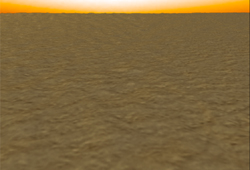
Mars Polar Lander
Mars Descent Imager (MARDI)
Simulated View of Possible Polar Lander Site
MPL MARDI Release No. MARDI99-01, 1 December 1999

Mars Polar Lander will arrive in the south polar region on December 3,
1999. The lander carries a camera that will take pictures during the
final two minutes of the descent. These dramatic views will show the
martian surface getting closer, and closer, and closer...until the
vehicle has safely landed (Note: the spacecraft must land safely to
get the pictures back). The artwork on the right shows the location
of Mars Descent Imager (MARDI) that will take these pictures.
On the left is a preview of what the polar landing site might look
like from a few hundred meters (several football fields) altitude
above the surface. This computer-generated view looks across the
polar layered terrain and towards the horizon. It was generated using
pictures taken over the past several months by the Mars Global
Surveyor (MGS) Mars Orbiter Camera (MOC). The landing site topography
was determined by using a shape-from-shading (photoclinometry)
computer program to examine a MOC image of a uniformly-frost covered
section of Mars Polar Lander's landing site. That same image was then
used in the computer to provide additional surface detail. This view
looks south-southeast across an area of ridged and rugged terrain
within Mars Polar Lander's landing ellipse. The horizon is about 10
km (6 miles) away. The illumination was chosen to approximate what
will be seen during the Polar Lander's descent on Friday. Real
pictures from the Mars Descent Imager are scheduled to be returned
over the weekend (December 3-6, 1999).
Image Credits:
Modeled View of Landing Site: NASA/JPL/Malin Space Science Systems
Artwork of Lander: NASA/JPL/Caltech; annotated by Malin Space Science Systems
MSSS Image Use Policy
Malin Space Science Systems built the MARDI and operates the camera
from its facilities in San Diego, CA. The Jet Propulsion Laboratory's Mars
Surveyor Operations Project operates the Mars Polar Lander
spacecraft with its industrial partner, Lockheed Martin Astronautics, from
facilities in Pasadena, CA and Denver, CO. The Mars Volatiles and Climate
Surveyor (MVACS) science payload is operated from a facility at the
University of California, Los Angeles.


